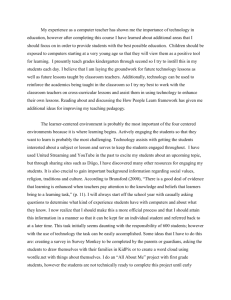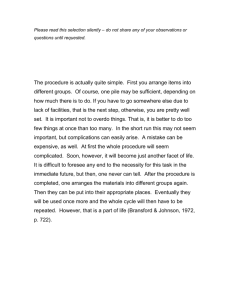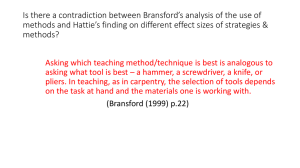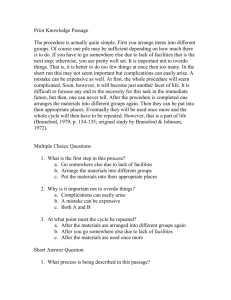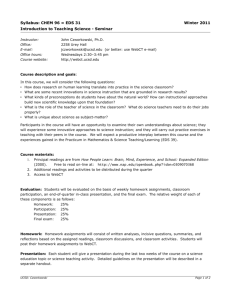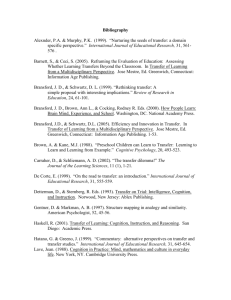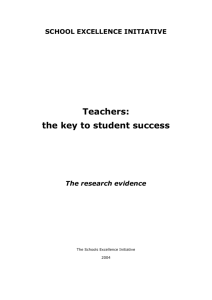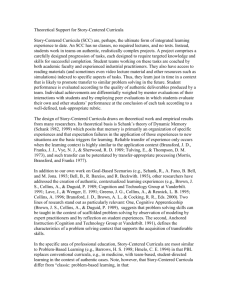“How People Learn” Framework and the STAR Legacy Inquiry Cycle
advertisement
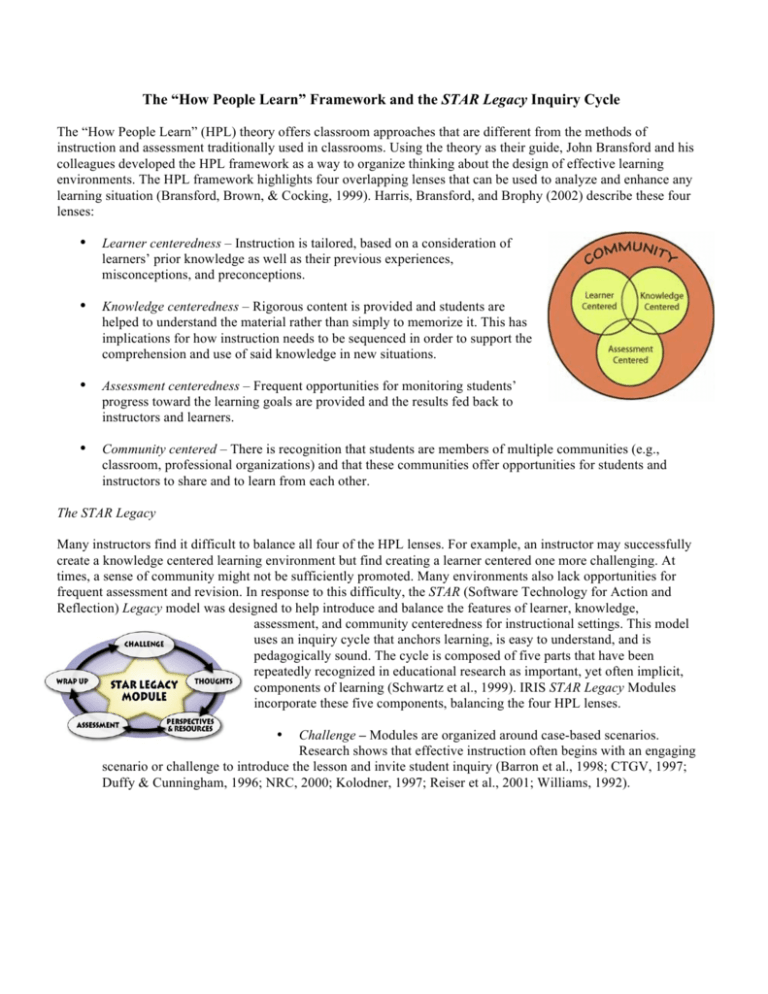
The “How People Learn” Framework and the STAR Legacy Inquiry Cycle The “How People Learn” (HPL) theory offers classroom approaches that are different from the methods of instruction and assessment traditionally used in classrooms. Using the theory as their guide, John Bransford and his colleagues developed the HPL framework as a way to organize thinking about the design of effective learning environments. The HPL framework highlights four overlapping lenses that can be used to analyze and enhance any learning situation (Bransford, Brown, & Cocking, 1999). Harris, Bransford, and Brophy (2002) describe these four lenses: • Learner centeredness – Instruction is tailored, based on a consideration of learners’ prior knowledge as well as their previous experiences, misconceptions, and preconceptions. • Knowledge centeredness – Rigorous content is provided and students are helped to understand the material rather than simply to memorize it. This has implications for how instruction needs to be sequenced in order to support the comprehension and use of said knowledge in new situations. • Assessment centeredness – Frequent opportunities for monitoring students’ progress toward the learning goals are provided and the results fed back to instructors and learners. • Community centered – There is recognition that students are members of multiple communities (e.g., classroom, professional organizations) and that these communities offer opportunities for students and instructors to share and to learn from each other. The STAR Legacy Many instructors find it difficult to balance all four of the HPL lenses. For example, an instructor may successfully create a knowledge centered learning environment but find creating a learner centered one more challenging. At times, a sense of community might not be sufficiently promoted. Many environments also lack opportunities for frequent assessment and revision. In response to this difficulty, the STAR (Software Technology for Action and Reflection) Legacy model was designed to help introduce and balance the features of learner, knowledge, assessment, and community centeredness for instructional settings. This model uses an inquiry cycle that anchors learning, is easy to understand, and is pedagogically sound. The cycle is composed of five parts that have been repeatedly recognized in educational research as important, yet often implicit, components of learning (Schwartz et al., 1999). IRIS STAR Legacy Modules incorporate these five components, balancing the four HPL lenses. Challenge – Modules are organized around case-based scenarios. Research shows that effective instruction often begins with an engaging scenario or challenge to introduce the lesson and invite student inquiry (Barron et al., 1998; CTGV, 1997; Duffy & Cunningham, 1996; NRC, 2000; Kolodner, 1997; Reiser et al., 2001; Williams, 1992). • • Initial Thoughts – Students then generate their own ideas in order to explore what they currently know about the challenge. Discovering the extent of students’ prior knowledge and experiences regarding the problemor case-based scenarios––and building upon that knowledge––is a means through which to enhance learning. This can be particularly true for students from culturally diverse backgrounds, who often struggle to learn content in ways that are antithetical to their learning styles (Cobb, 2001). • Perspectives and Resources – Next, students access resources relevant to the challenge. These resources are presented as nuggets of information and may include text, interviews with experts, movies, and interactive activities. These resources often provide “ah ha!” experiences when the students learn about points that they did not initially consider. • Assessment – Students eventually receive assessment opportunities to apply what they know, with the opportunity to return to the Perspectives and Resources section if needed. • Wrap Up – The cycle then concludes with a summary and an opportunity for the student to review his or her Final Thoughts (which are the same questions asked in the Initial Thoughts section of the module). Learning is considered to have occurred when there is disparity between initial and final thoughts, with greater disparity indicating greater learning (e.g., Bransford, 1979; Schwartz & Bransford, 1998). Research Findings Research concerning the effectiveness of HPL and STAR Legacy has demonstrated positive outcomes in college classrooms. Roselli and Brophy (2003) found that in an undergraduate biomechanics course students rated modules quite positively in terms of effectively communicating key concepts and stimulating interest. In addition, systematic and structured observations of a sample of class sessions were compared for sections that relied on traditional taxonomy-based instruction versus the HPL strategy; the latter included more learner-centered, knowledge-centered, assessment-centered, and community-centered behaviors by both the instructor and students. Using a scale of 1 (low) to 5 (high), 69.7% of the students in the “HPL courses” rated communications effectiveness as a 4 or 5, compared to only 33.6% of students in the traditional courses (see graphs below). Fifty-seven percent of the students in the HPL course gave ratings of 4 or 5 for stimulating interest versus 26% of students in the traditional course. Both the course (53.1% vs. 23.7%) and the instructor (69.7% vs. 37.6%) were judged more favorably (i.e., received higher percentages of 4 and 5 ratings) by students in their final course evaluations. The IRIS Center conducted a study of the learning outcomes of one IRIS Module at a large urban campus with a diverse student body (n=620). The module’s content pertained to making instructional accommodations for students with visual disabilities. Three instructors taught the course without the IRIS Module and then taught the course with the IRIS Module. Students in each condition were administered a pretest and posttest. Because the module included content that was common to both the module and the textbook and content that was unique to the module, student responses were assessed based on the content that was reflected (common versus unique). In terms of how much they changed from the pretest to the posttest, positive gains in learning occurred for both types of content. Not surprisingly, students demonstrated greater gains in knowledge unique to the module in the module condition versus the no module condition (see the first graph below). More interestingly, students in the module condition also demonstrated greater gains in knowledge common to the text and the module than did those students in the no module condition for Instructors 1 and 3 (see the second graph below). Students in Instructor 2’s class showed no difference in learning common content in the two conditions. These findings suggest that the STAR Legacy Module format may boost learning over and above what is learned from a textbook alone. Average Gain in Learning from Pre- to Posttest: Content Covered by Module Only 3.5 3 2.5 2 1.5 1 0.5 0 Instructor 1 Instructor 2 Instructor 3 Instructor Unique content - No module condition Unique content - Module condition References Barron, B. J., Schwartz, D. L., Vye, N. J., Moore, A., Petrosino, A., Zech, L., Bransford, J. D., & CTGV. (1998). Doing with understanding: Lessons from research on problem solving and project based learning. Journal of Learning Sciences (3&4), 271–312. Bransford, J. D. (1979). Human cognition: Learning, understanding, and remembering. Belmont, CA: Wadsworth. Bransford, J. D., Brown, A. L., & Cocking, R. R. (Eds.). (1999). How people learn: Brain, mind, experience, and school. Washington, DC: National Academy Press. Cognition and Technology Group at Vanderbilt (CTGV). (1997). The Jasper Project: Lessons in curriculum, instruction, assessment, and professional development. Mahwah, NJ: Lawrence Erlbaum Associates. Duffy, T. J., & Cunningham, D. (1996). Constructivism: Implications for the design and delivery of instruction. In D. H. Jonassen (Ed.), Handbook of Research for Educational Communications and Technology (pp. 170–198). New York: Macmillan. Harris, T. R., Bransford, J. D., & Brophy, S. P. (2002). Roles for learning sciences and learning technologies in biomedical engineering education: A review of recent advances. Annual Review of Biomedical Engineering, 4, 29–48. Kolodner, J. L. (1997). Educational implications of analogy: A view from case-based reasoning. American Psychologist, 52(1), 57–66. Martin, T., Pierson, J., Rivale, S., Vye, N., Bransford, J., & Diller, K. R. (2007). The role of generating ideas in challenge-based instruction. In W. Aung, J. Moscinski, M. Da Graca Rasteiro, I. Rouse, B. Wagner, & P. Willmot (Eds.), World innovations in engineering education and research. Arlington, VA: iNEER. Martin, T., Rivale, S. D., & Diller, K. R. (2007). Comparison of student learning in challenge-based and traditional instruction in biomedical engineering. Annals of Biomedical Engineering, 35(8), 1312–1323. National Research Council (NRC). (2000). How people learn: Brain, mind, experience, and school (Expanded Edition). Committee on Developments in the Science of Learning. J. D. Bransford, A. L. Brown, & R. R. Cocking (Eds.), with additional material from the Committee on Learning, Research and Educational Practice. Commission on Behavior and Social Sciences and Education. Washington, DC: National Academy Press. [Online]. Available from http://www.nap.edu/html/howpeople1/. O’Mahony, T. K., Vye, N. J., Bransford, J. D., Stevens, R., Stephens, R. D., Richey, M. C., Lin, K. Y., & Soleiman, M. K. (2012). A comparison of lecture-based and challenge-based learning in a workplace setting: Course designs, patterns of interactivity, and learning outcomes. The Journal of the Learning Sciences, 21, 182–206 Reiser, B. J., Tabak, I., Sandoval, W. A., Smith, B. K., Steinmuller, F., & Leone, A. J. (2001). BGuILE: Strategic and conceptual scaffolds for scientific inquiry in biology classrooms. In S. M. Carver & D. Klahr (Eds.), Cognition and instruction: Twenty-five years of progress (pp. 263–305). Mahwah, NJ: Lawrence Erlbaum Associates, Publishers. Roselli, R. J., & Brophy, S. P. (2003). Redesigning a biomechanics course using challenge-based instruction. IEEE Engineering in Medicine and Biology, 22, 66–70. Schwartz, D. L., & Bransford, J. D. (1998). A time for telling. Cognition & Instruction, 16, 475–522. Schwartz, D. L., Brophy, S., Lin, X., & Bransford, J. D. (1999a). Flexibly adaptive instructional design: A case study from an educational psychology course. Educational Technology Research and Development. Schwartz, D. L., Lin, X., Brophy, S., & Bransford, J. D. (1999b). Toward the development of flexibly adaptive instructional designs. In C. Reigeluth (Ed.), Instructional-design theories and models: New paradigms of instructional theory, Vol. II (pp. 183–213). Mahwah, NJ: Erlbaum. Williams, S. M. (1992). Putting case-based instruction into context: Examples from legal and medical education. The Journal of the learning Sciences, 2(4), 367–427.
